
![]()
![]()
| 1998 NSF Annual Report
YEAR-FOUR DEB-9505031, $194,463, 15 August 199831 July 1999 BIODIVERSITY OF THE KURIL ARCHIPELAGO:
|
|
GOALS.Following the success of our 1994 "proof of
concept" award (see 1994 NSF Project Report),
and Years One, Two, and
Three of the present grant (see 1995,
1996, and 1997 NSF
Annual Reports), the primary goal of this fifth of six expeditions to the Kuril
Archipelago was to return to the southernmost
islands of the chain:
Kunashir, Iturup,
Shikotan, and the five isles of the
Habomai Group (Polonskogo, Zelionyi, Tanfilyeva,
Iurii, and Anuchina).
Although we made large collections on
the southern islands in 1994, only 31 actual field days were available to us,
many of the numerous available habitats were inadequately surveyed, and
major taxa were not collected (e.g., plants and terrestrial insects); it was
thus crucial that we return to these islands, the most biologically diverse
of the chain. Reflecting a change in the scope of the project, approved by
NSF in January 1996, we determined to redirect efforts and resources toward
invertebrates (primarily terrestrial insects) at the expense of birds and
mammals (see Island Info). In every way
these goals were met.
|
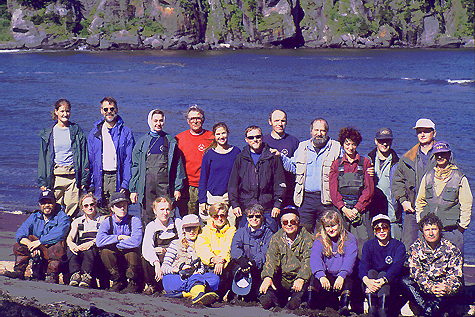 1998 IKIP participants on the northern shore of Shikotan. Photo by IKIP. |
RESULTS TO DATE.An international team of 28 scientists and students (see Project Participants, 1998 Expedition) met in Vladivostok, Russia, on 21 July 1998, boarded the 75-m Akademik Oparin, a research vessel of the Russian Academy of Sciences, and spent 25 days in the field. As planned, eight islands at the southern end of the Archipelago were visited. Collections were made at 1,190 sites (see IKIP Databases)somewhat fewer than the 1,311 sites collected in 1997, but slightly more than the 1,142 sites collected in 1996 and 1,167 sites in 1995 (193 sites on Kunashir, 437 on Iturup, 316 on Shikotan, 60 on Polonskogo, 31 on Zelionyi, 67 on Tanfilyeva, 50 on Iurii, and 36 on Anuchina see Habomai Group; also see Map-based locality record browser)in widely varying habitats, similar to those collected in previous years (see Macro- and microhabitats of the Kuril Islands): from sea-level sandy-, rocky-beach, and grassland to high-mountain stream/conifer forest; from deep, slow-moving lowland rivers to fast-flowing gravelly streams; and from sphagnum bogs to high mountain lakes.
|
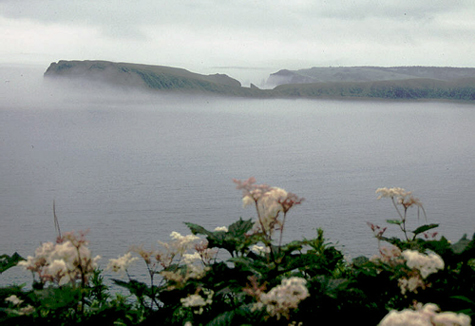
A foggy day on Shikotan looking across Tserkovnaya Bay. Photo by Dan Bennett. |
Collecting was confined primarily to vascular plants, aquatic and terrestrial insects, spiders and harvesters, freshwater and terrestrial mollusks, freshwater and anadromous fishes, amphibians, and reptiles (smaller collections of fungi, lichens, mosses, liverworts, pseudoscorpions, mites, decapods, water fleas, centipedes, millipedes, and marine fishes were also made). In addition to some bad weather, certain uncontrollable difficulties inherent in the project repeated themselves this year (such as impenetrable vegetation making adherence to transects impossible and difficult shore landings at some sites). However, the problems we experienced in 1994 of gaining access to certain islands and to sites within islands did not reoccur. Our research vessel, the 75-m Akademik Oparin, which also served as our base of operations in 1996 (the 68.8-m Professor Bogorov was used 1994, 1995, and 1997) was very comfortable and ably managed by its Russian crew of 32 (see Russian Research Vessels). |
 Our Research Vessel, the 75.5 m AKADEMIK OPARIN.
Photo by Dan Bennett.
Our Research Vessel, the 75.5 m AKADEMIK OPARIN.
Photo by Dan Bennett. |
RESEARCH PRODUCTS.Although counts are still preliminary, approximately 63,235 specimens were successfully exported to the U.S. (compared to 53,155 specimens exported in 1997; 63,700 in 1996; 45,080 in 1995; and 29,600 in 1994):
|
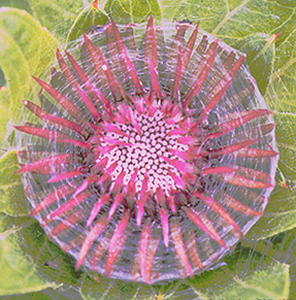
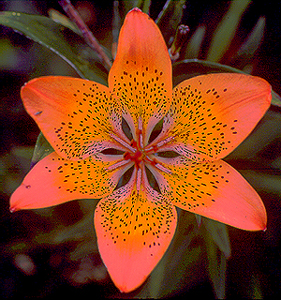
Cirsium kamtschaticum (left) and Lilium dauricum (right), both from Iturup. Photos by Sarah Gage. |
Plants: about 3,300 specimens of vascular plants, representing 58 families and approximately 320 species, plus over 1620 specimens of lichens (included here among plants for convenience only), and 800 bryophytes (mosses and liverworts), for a grand total of approximately 5,720 specimens; two or three lichen and bryophyte taxa appear to be new to science; about 360 new records of vascular plants for various islands (for which plant collections have not previously been reported) and, among lichens and bryophytes, at least 15 new records for the Archipelago. Aquatic insects: 5,694 specimens, representing 34 families and a minimum of 127 species, of which 29 represent new records for various islands and eight represent new records for the Archipelago. Terrestrial insects: about 30,238 specimens, representing 17 orders, about 90 families, and perhaps as many as 650 species; the material undoubtedly includes new taxa and many new records, but less than half the collection has been sorted to species and much is not yet even sorted to family. (For a comprehensive report on aquatic and terrestrial insects, see IKIP Insect Report.) |
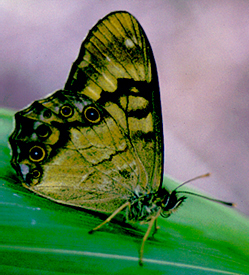
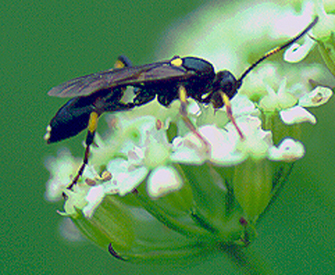
Zophoessa callipteris (left) from Kunashir and an ichneumonid wasp (subfamily Ichneumoninae) (right) from Iturup. Photos by Brian Urbain. |
Spiders and harvesters: about 4,260 specimens, representing at least 20 families and 150 species, including a large green orbweaver, Araneus boreus, described from Japan in 1972 and a new record for the Kuril Islands; many other new records and some new species may be expected, but much of the material remains to be sorted and identified (prior to IKIP-98, spiders had never been reported from four of the islands visited this year: Polonskogo, Anuchina, Tanfilyeva, and Iurii). Mollusks: 5,240 specimens, representing 21 families and a minimum of 33 species, of which at least two appear to be new to science, and of which 69 represent new species records for various islands; seven represent new species records for the Archipelago (the discovery of a new species of Succineidae on the relatively well-studied Island of Kunashir is a real surprise; also it is interesting to note that we found more species but fewer individuals per unit effort on the southern islands compared to collecting in previous years on the northern Islands). Freshwater fishes: 11,424 specimens, seven families, and 18 species, seven of which represent new records for islands of the Habomai group (prior to IKIP-98, freshwater fishes had never been reported from Polonskogo, Anuchina, Tanfilyeva, and Iurii). Marine fishes: 605 specimens, 16 families, and 53 species, 27 of which are new records for the Archipelago. Amphibians and reptiles: 54 specimens, three families, and three species; a frog, Rana pirica, is newly recorded from Polonskogo and Iurii. |
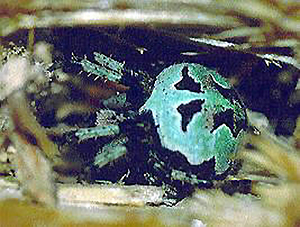
The orbweaver Araneus boreus collected on Kunashir, a new record for the Kuril Archipelago. Photo by Brian Urbain. |
The plants, spiders and harvesters, fishes, amphibians, and reptiles, are presently being identified and cataloged here at the University of Washington in the Department of Botany, Burke Museum of Natural History and Culture, and School of Aquatic and Fishery Sciences, respectively. General oversight of the aquatic and terrestrial insects (i.e., loans of specimens, data compilation, etc.) is being coordinated by Noboru Minakawa and Brian K. Urbain (both full veterans of IKIP since its inception), respectively, and all material will be archived in the Department of Entomolgy at the California Academy of Sciences, San Francisco. The mollusks are being processed by Timothy A. Pearce (veteran of IKIP-96 and -97) of the Delaware Museum of Natural History, Wilmington, but eventually destined to join previously collected and cataloged IKIP material at the Museum of Zoology, University of Michigan, Ann Arbor. Curatorial work on the mollusks and vertebrates is well in hand, but much remains to be done with the plants and other invertebrates. |
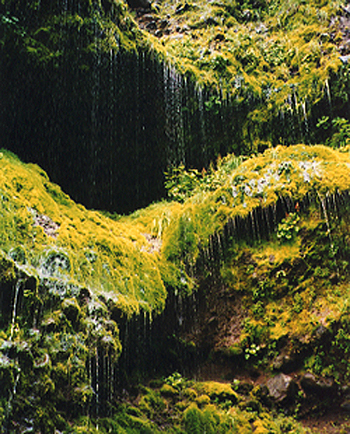
Lush, dripping-wet vegetation on a vertical rock wall on Iturup, providing microhabitat for a myriad of tiny organisms. Photo by Erin MacDonald. |
Considerable time and effort has gone toward creating, maintaining, and updating an IKIP web-site, the heart of which is our search gateway to IKIP Databases: (1) Forms-based database search gateway, (2) Map-based locality record browser, and (3) Loans and Gifts of IKIP material (please note that our IKIP web-site was developed without the use of NSF funds). Since our return from the Kurils in September 1998, we have been working hard to make all our data available electronically, but dealing with tens of thousands of specimens, it has been a major undertaking. All of our locality data, from 1994 through 1998, are on-line (5,349 sites on 31 islands) and we have entered 11,925 taxonomic records (more than double last year's total). To date, all of the following have been identified, cataloged, and made available on the web-site: all vascular plants, lichens, mosses, and liverworts collected from 1995 through 1997; Araneae (spiders), Opiliones (harvesters), Acari (mites), Lithobiomorpha (stone centipedes), Ephemeroptera, Plecoptera, aquatic Coleoptera, phorid Diptera, Trichoptera, and formicid Hymenoptera collected from 1994 through 1997; all Odonata, heteropteran Hemiptera, and silphid Coleoptera collected from 1994 through 1996; all Dermoptera, Psocoptera, sternorrhynchan Hemiptera, Neuroptera, cerambycid Coleoptera, and mollusks collected in 1994 and 1995; all fishes, amphibians, and reptiles collected from 1994 through 1998; all carabid Coleoptera collected in 1994; all histerid and cholevid Coleoptera collected in 1995; all Cladocera, and braconid and bethylid Hymenoptera collected in 1996; all syrphid Diptera collected in 1997(see Table 1). |

Graduate students (clockwise from lower left) Theresa Landewe, Erin L. MacDonald, Duane E. Stevenson collecting fishes on Iturup. Photo by Brian Urbain. |
HUMAN RESOURCE DEVELOPMENT.Three University of Washington undergraduates, Suzanne Joneson (plants), Daniel J. Bennett (terrestrial insects), and Lucie J. Weis (aquatic insects) (the former two supported by REU funds, see below), and three University of Washington graduate students, Erin MacDonald, Theresa Landewe, and Duane Stevenson (fishes), all full participants in the 1998 expedition, received training in field work, curatorial practices, and systematics within their areas of interest. Their experience continues here at home as collections are being sorted and identified, and publications prepared. We have also provided curatorial training and experience to a number of unpaid volunteers at the Burke Museum. The most productive of these individuals has been Janet Wall who continues to be immensely valuable to us in working with IKIP spiders and harvesters. Between 23 April and 30 December 1998, Janet worked 207.5 hours, during which time she completed the massive job of double-checking, plotting, and correcting all the locality data for all spiders collected in 1996, and made a good start doing the same for 1997 data. During curation of the 1996 specimens she was responsible for cutting, washing, and inserting the final labels into vials, filling and stoppering the vials, and arranging and integrating the material with prior collections. In addition, Janet did about half the data entry required to incorporate the 1996 data into the IKIP database; she also processed loans and performed other miscellaneous work. |

1998 REU participant and entomologist extraordinaire, Daniel J. Bennett. Photo by Valentina Teslenko. |
Research Experiences for Undergraduates supplemental support received in 1998 was well used. One of the two recipients, Daniel J. Bennett, now a senior zoology major at the University of Washington, proved to be an invaluable and extremely dedicated member of the terrestrial insect team during IKIP-98. A fast learner, he readily grasped the purpose of a wide variety of collecting equipment and techniques, and applied them correctly to the wide array of habitats encountered in the southern Kuril Islands. He soon developed a quick and skilled eye for recognizing unique microhabitats and often produced unusual material that the beginning collector normally misses. As such, he ably assisted in the collection of approximately 34,340 insects (5,850 aquatic and 28,490 terrestrial), which he helped to sort, label, and identify to order, much of the work accomplished while still aboard the research vessel. He was responsible also for keyboarding nearly all our 1998 locality data, a huge task that was accomplished without error. Since our return from the Kurils in September, Dan has remained enthusiastic and committed to the project, working almost every day in our lab despite a full academic load. Here he is perfecting the basic procedures of curation, from generating labels to pinning specimens, all the steps required to prepare insect material for permanent archival storage and professional research. At the same time, he is developing skills in specialized curatorial methods, such as critical-point drying of alcohol preserved insects, and microscopic glue-point mounting of our smallest and most delicate specimens. He is also getting the chance to correspond and interact with systematists around the world as we send various taxa out on loan for identification. Overall, his experience on the Kuril Islands has had a profound effect on him: featured in the University of Washingtons 1998 Report to the Washington State Legislature, Dan is quoted as follows: "I came here [to the University of Washington] because I knew this was a tremendous school for science, but I had no idea, when I was a freshmen, that faculty encouraged and relied on undergraduates in their research." The six-week expedition, says Dan, was "life-changing. I went to the Kurils to find out what its actually like to be working in the forefront of this field. I did find outand its given me a passion for what taxonomists do, the discovery part. Each day was such an incredible adventure." Dan is now investigating graduate programs in entomologyhe plans to specialize in the Braconidae, a family of parasitic wasps. |

1998 REU participant and accomplished lichenologist, Suzanne Joneson. Photo by Brian Urbain. |
Suzanne Joneson, the second recipient of 1998 REU support, now a senior botany major, began working for IKIP in January 1998. During winter and spring quarters, she identified over 1,000 vascular plants (collected by us in the Kurils in 1996 and 1997) and entered the identifications, along with field notes, into the IKIP database. She also organized all the IKIP collections of Hypogymnia for loan to colleagues at Oregon State University and facilitated work by the Seattle Lichen Group that resulted in the identification of IKIP lichens collected in 1996, 1997, and 1998. In preparation for the 1998 expedition, Suzanne helped prepare and package supplies and equipment. During the expedition itself, she collected 828 numbers (357 vascular plants, 385 lichens, and 86 bryophytes) in multiple replicates, resulting in over 2,500 specimens. She was energetic and enthusiastic in the field and in the ships laboratory, where processing specimens and writing notes would go late into the night, seven days a week. Her notes are accurate, complete, and wonderfully neat. Suzannes work on Kuril Island lichens will result in at least one paper. She will also be a co-author on papers resulting from our collecting efforts on the islands of the Habomai group. Suzanne is now preparing applications to graduate schools in botany, where she plans to concentrate on lichen systematics.
LOANS AND GIFTS.We have worked hard to make our
material available to the international scientific community through
loans
and gifts of specimens. To date, we have made 82 loans and gifts (whole
specimens as well as tissues fixed in ethanol) to 59 specialists around the
world, totaling 3,740 lots and 42,068 specimens. |
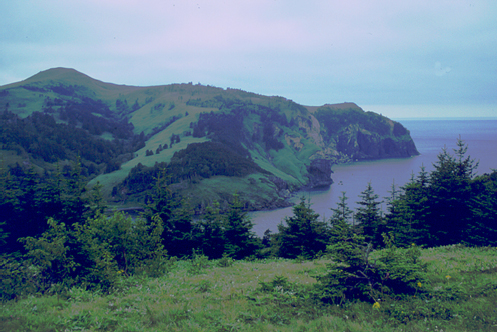
Coniferous forest on the northern margin of Shikotan. Photo by Dan Bennett. |
SEMINARS AND MEDIA ATTENTION.We have made a concerted effort to inform academic as well as public audiences about IKIP through oral presentation, and have received considerable attention from the media in return. To date, veterans of IKIP have presented more than three dozen scientific talks and have been the subject of more than three dozen articles in newspapers and magazines. The 1996 expedition was recorded in full by three employees of the Hokkaido Television Broadcasting Co. (Yasumasa Shinomiya, writer; Osamura Hidetoshi, photographer; and Nikolai Shapotin, interpreter), resulting in a 30-minute television production that was aired in Japan on 2 March 1997. A 90-minute show on the people and general natural history of the Kuril Islands, which aired in April 1997, also featured IKIP-1996. Copies of these videos were made available to NSF in spring 1997. The 1997 expedition was recorded in full by South Korean Television, Soo Yong Park, Producer, but we have not yet received copies of the video. As mentioned above, the 1998 Expedition was featured in the University of Washington's 1998 Report to the Washington State Legislature. Focusing primarily on Daniel J. Bennett, a recipient of REU support last year, the text of the report is quoted here in part: Voyagers: A Student and His Mentor: "That was a great day, "says biology student Dan Bennett, remembering his first invitation to join a faculty research project. "I came here [to the University of Washington] because I knew this was a tremendous school for science, but I had no idea, when I was a freshmen, that faculty encouraged and relied on undergraduates in their research." Dan has had that experience . . . with fisheries professor Ted Pietsch. |
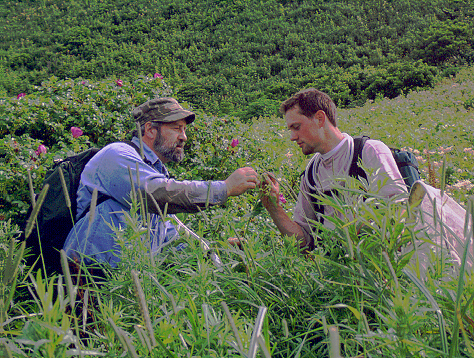
Dan Bennett (right) and P.I. Ted Pietsch, collecting insects on Iturup. Photo by Brian Urbain. |
Pietsch had organized a five-year international research project in biodiversity and won funding for it from the National Science Foundation. A few undergraduate students, also funded by the grant, could join the trip each summer. Dan applied and was one of two undergraduates chosen to participate in 1998. Destination: the Kuril Islands, a remote, windswept archipelago stretching from Russia to Japan in the North Pacific. Mission: collecting and cataloging specimens of the islands' wildlife, before development (now being encouraged by the Russian government) destroys this diverse and unspoiled ecosystem. Colleagues: American, Russian, and Japanese scientists. Headquarters: a Russian research ship from which small boats set out each day to carry researchers to their work on the islands. Dan, who'd had an interest in bugs since his boyhood, was assigned to the expedition's insect team. He trained with Pietsch for weeks before the trip. The six-week voyage, says Dan, was "life-changing. I went to the Kurils to find out what its actually like to be working in the forefront of this field. I did find outand its given me a passion for what taxonomists do, the discovery part. Each day was such an incredible adventure. " One Russian scientist was even translating books for me. And Ted makes you really want to do great scienceto make him proud of you. PUBLICATIONS.Fifty papers have now been published. An additional seven are in press, another four have been submitted, and about 25 are at various stages of preparation. Thirty-six descriptions of new taxa have been published or are currently in press or submitted for publication: three new species of caddisflies (Trichoptera: Hydroptilidae, Leptoceridae), two new stoneflies (Plecoptera: Perlodidae), one new beetle (Coleoptera: Carabidae), six new flies (Diptera: Phoridae, Scathophagidae, Syrphidae), one new bug (Hemiptera: Miridae), ten new parasitoid wasps (Hymenoptera: Braconidae), one new genus and two new species of mites (Acari: Acaridae, Eviphidae), one new millipede (Diplopoda: Diplomaragnidae), four new freshwater bivalves (Bivalvia: Unionidae, Anodontidae), five new terrestrial and freshwater gastropods (Gastropoda: Planorbidae, Valvatidae), and one new fish (Teleostei: Osmeridae).
Among our larger publication efforts is Y. N.
Zhuravlev and A. S. Kolyada's book on the
biology of ginseng published
in 1996: Araliaceae: Ginseng and Other
Aralia of the Russian Far
East, Dalnauka, Vladivostok, 280 pp., 41 black and white figures, 8
color plates, 11 tables, and 859 bibliographic references. That portion of
the book that covers Kuril Island species was funded in part by DEB-9400821
and DEB-9505031; NSF is properly acknowledged on page 1 of the front
matter. |
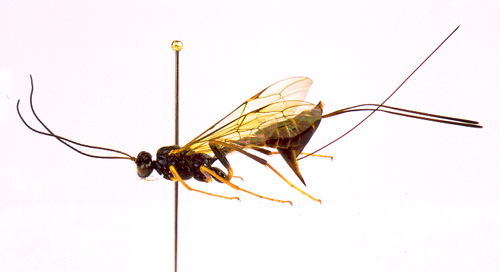
An ichneumonid parasitoid wasp, Coleocentrus incertus ASHMEAD, 1906, collected on Kunashir. Specimen prepared by Brian Urbain. Photo by Patricia L. McGiffert |
Our second larger publication effort, for which we received supplemental support from NSF, is an English translation of G. O. Krivolutskaja's Entomofauna of the Kuril Islands, originally published in 1973 by the Institute of Biology and Soil Sciences, Far-Eastern Scientific Center, Russian Academy of Science, which will be edited, augmented, illustrated in color, and made available electronically. The book has now been completely translated by Elliott B. Urdang, M.D., M.A. (in Russian), of Providence, Rhode Island, and all parts have been delivered to us by diskette and hard-copy: the Abstract, Preface, and Table of Contents (5 pages), Chapter 1, "History of investigations of the insect fauna of the Kuril Islands" (7 pages); Chapter 2, "General information on the insects of the Kuril Islands" (8 pages); Chapter 3, "Accounts of insect taxa of the Kuril Islands" (including methods and materials, keys, descriptions, and general taxonomic accounts by order; 130 pages); Chapter 4, "Ecological and geographic review of the Kuril Island entomofauna" (including physical conditions of the Kuril Islands, ecological features of the Kuril Islands, and insect assemblages and primary habitats of the Kuril Islands; 82 pages); Chapter 5, "Speciation on the Kuril Islands" (10 pages), Chapter 6, "Zoogeography of the Kuril Island entomofauna" (including geological history and floral evolution, zoogeographic origins and trends, and subdivision of the Kuril Archipelago based on insect distributions; 28 pages); Conclusions (4 pages); Summary (2 pages); Literature cited (15 pages), Index of scientific names of insects (19 pages); List of scientific and Russian names of plants (2 pages); all the tables (22); and the legends to all the figures (67). While some of the text requires additional editing, the entire book, including all figures and tables, is now available on the web-site. Color illustration of the work, with photographs taken by members of the IKIP insect team, is in progress. Similar plans to publish electronically V. Y. Barkalov's Plants of the Kuril Islands, are currently on hold while we await delivery of the manuscript. Although promised to us back in June 1997, his approximately 650-page work remains unfinished.
NEW DIRECTIONS.Probably the most exciting thing
that happened this past year was the discovery of an undisturbed Ainu site at Nemo Bay
on the uninhabited northern Kuril
Island of Onekotan.
Actually found during our 1996 expedition to the northern part of the
Archipelago, its significance was not appreciated until late 1998 when
University of Washington archeologistsled by Dr. Karl Hutterer, Director of
the Burke Museumwere
shown photographs of the site. |

Remains of circular pit houses of Ainu culture at Nyemo Bay, northern end of Onekotan Island. Tiny person at left of center providing scale. Photo by Brian Urbain. |
The site consists of the remains of at least a dozen circular dwellings or pit houses (the largest about 22 meters in diameter), some over-lapping, indicating a long history of occupancy of aboriginal peoples. University of Washington colleagues are very interested in excavating not only this site, but conducting a full reconnaissance of Onekotan and eventually other islands of the Archipelago. We hope to explore the possibility of extending the Kuril Island project through the summer of 2000, that is, adding a supplemental year of funding, to support a unique collaboration with Russian, Japanese, and American biologists and archeologists.
Ainu culture is unknown north of Hokkaido. A full-scale
archeological excavation, coupled with intense biotic survey and inventory of
Onekotan, would make a significant contribution. The infrastructure to make
this possible is already in place. To mount an Ainu expedition independent of
our existing Kuril Island project would be very difficult, extremely expensive,
and certainly of lesser scientific interest and significance. It is hoped that
three programs within NSF (Survey and Inventory, International Programs, and
Archeology) might come together to make an Ainu expedition possible in 2000.
Archeologists in Japan and Russia are eager to join in this
venture. PLANS FOR SUMMER 1999.We are now in preparation for the coming summer expedition (approximately 20 July8 September 1999). Having now collected on all the named islands of the Archipelago, this fifth expedition will concentrate on the flora and fauna of the southern end of Kamchatka, an important source biota for the Kurils. On our way back down the chain, we will also return to various islands, those places that are of special interest and require additional collecting (see Map-based locality record browser). Thank you for the generous support we have received. We hope this brief report meets with your satisfaction.
|
![]()
